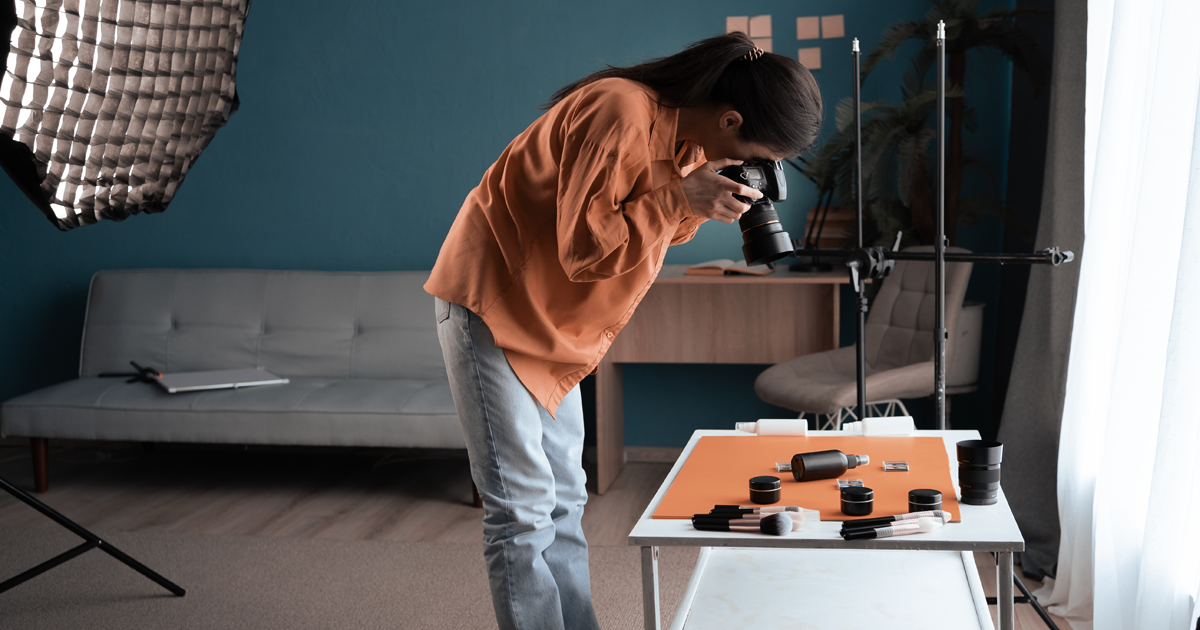They say a picture is worth a thousand words. For brands today, just one picture can be the difference between thousands of words…and dollars.
In the age of social media, we live life in photos—endlessly scrolling through friends’ travel photos and aesthetic ‘before and after’ photos showing off a favorite influencer’s new kitchen.
But with over 1,000 photos being uploaded to platforms like Instagram every second and users spending an average of 53 minutes scrolling feeds each day, capturing the eye of just one of the platform’s 1.4 billion users has become more competitive than ever as brands fight friends, influencers, celebs, and more for the spotlight.
Product photography can play a huge role in the success of a brand. It’s no longer about getting the most aesthetic, clean shot—it’s about standing out. The overly saturated retail market means brands must forget everything they think they know about product photography and turn their marketing efforts upside-down and backwards in order to truly stand out and secure time on the media mic without breaking the bank.
CASE STUDY: Office Depot – Turning Office Supplies into Digital Eye Candy
With so much to consider, where do brands even begin? Here are a few expert product photography tips to help buried brands rise to the top!
A Brand’s Guide to Picture-Perfect Product Photography
Before brands can capture picture-perfect product shots, they must first identify the types of photography that will best suit their needs.
Securing a Style
Silhouette product photography, also known as ‘white background’ photography, is the most common, most widely used form of product photography due to hi-res pixel quality, opportunity for capturing angles, and clean, distraction-free appearances. Historically, brands utilize this style of photography in more shopping-focused environments, like e-commerce or catalog. No-nonsense, white background product photography lets brand’s goods do the work.
Lifestyle product photography, often known as ‘in-situ’ photography, is the best way for brands to show their products and services in action—or in situation, if you will. Shooting lifestyle allows brands to build context around the product or service they’re selling through the creation of unique, ‘real feel’ settings that consumers envy and seek out for themselves—making them perfect visuals for evoking emotion, building trust, and inspiring on social media ads, billboards, emails, and more.
With so many options, brands may feel overwhelmed, especially when thinking about the costs associated with securing picture-perfect shots for their photo library. Here’s the thing: No budget, no problem! From professional cameras to simple iPhone captures to User-Generated Content (or UGC) collection, picture-perfect product photography is always within reach.
Planning Yields Perfection
It’s all about details, details, details. As brands prepare for a product shoot, it’s important that stakeholders meet to outline a plan, focusing on everything from their desired aesthetic to how they might use the final files in advertising.
Brands consider the following before looking through the lens:
- Lifestyle, white background, or both?
- Key products to spotlight
- Location options and their backgrounds
- Smart scaling
- Brand color palettes
- Additional prop or on-set model needs
- Photo orientation and potential cropping
- Final file usage
- The overall message these photos should portray
Consistency Improves Brand Recognition
Maintaining consistency, like lighting, scaling, and setting, not only brings uniformity to your brand photo library, but consistent photography improves brand recognition amongst consumers—leading them to shop a product just because it feels familiar to them.
Use these tips for brands looking to lock down a consistent aesthetic:
- For ‘white background’ photography, use the same white seamless to capture all stand-alone product shots
- For lifestyle photography, don’t worry about ever-changing backgrounds—focus energy on overall color choices, editing, and general location
- Keep scaling as accurate as possible to best represent products details and sizes
Leveraging Customer Content
User-generated content (or UGC) is an often-under-leveraged goldmine for brands looking for real, authentic portrayals of their products and services. Not only is UGC beneficial for brands themselves, UGC content also puts consumers in the driver’s seat to showcase their own unique storytelling perspectives or demonstrate viral hacks.
Brands who regularly socialize with their consumers increase their chances of securing top-notch creative for their social media channels, building relationships with future brand ambassadors or influencers—we helped our friends at Panasonic Gaming achieve it!—and boosting product sales.
Saying it with SEO
SEO, or search engine optimization, isn’t just for blog and website content—it’s starting to change the way consumers interact with brand advertisements and social media posts! Brands can use SEO to their advantage by following these important tips:
- Downsize image resolution to reduce webpage loading times (consumers want fast results and are more likely to abandon cart when pages start to slow)
- Use keyword-heavy file naming conventions
- Add alternate text to all photos to increase search rankings and engage with visually-impaired consumers
- Reference relevant keywords in image copy—like we and our friends at Panasonic Grooming did here—to boost quotes or facts
Better Product Photography Calls for Learning, Earning, and Growing
Creating a product photo that’s worth a thousand words (or one that yields thousands of dollars in sales) doesn’t have to break a brand budget. With the right creative partner like AGAIN Interactive, brands can achieve smart, standout product photography that boosts affinity, sales, loyalty, and more.
Ready to create with us? Drop us a line at info@againinteractive.com for more.

Noelle Pagliei
Part of the creative team at AGAIN, Noelle loves to help clients stand out through compelling and eye-catching design. When she’s away from Photoshop, you can find her trying new restaurants, watching a good TV series, or hanging out with friends.
